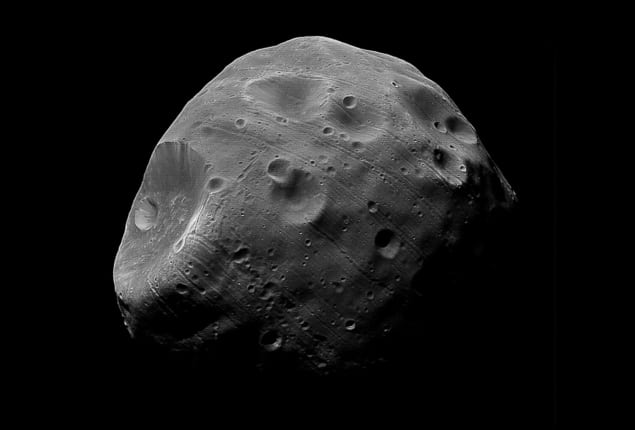In this article (originally published in Lateral Thoughts, Physics World’s regular column of humorous and offbeat essays, puzzles, crosswords, quizzes and comics, which appears on the back page of the print edition) Nicholas Porter looks into the physics of wonky satellites, both fictional and real

Children’s author Julia Donaldson and illustrator Axel Scheffler are probably best known for their book The Gruffalo. But the duo recently put forth a new offering, whimsically titled The Smeds and the Smoos, featuring two types of aliens. The Smeds, who are red, never mix with the Smoos, who are blue. At the end of this tale of love, friendship and seeing past our differences, the now-amicable Smeds and Smoos celebrate “by the light of the silvery squoon”, an irregular, wonky natural satellite of their planet. But if a planet had a squoon, would beings on that world be able to see it, or would it be too small to view with the naked eye?
Well let’s think about the physics: for a satellite to be wonky, it must be small. This is because for a given object, above a fixed limiting radius, gravitational forces dominate cohesive forces, causing the object to be become regular and spherical. For typical astronomical objects, this radius (aka the potato limit) is approximately 200–300 km, providing an upper limit for the radius of our irregular squoon. So because the squoon has to be small, to resolve it with sufficient detail, it must be relatively close to the surface of its host planet. But getting close to a planet is perilous. Veer too near to a massive body, and a satellite can be torn asunder by the host planet’s tidal forces, limiting how close the squoon can approach the planet.
Our eyes have a minimum angular resolution of about 0.3 mrad, approximately equivalent to resolving a human hair’s width at arm’s length from the eye. If we assume that our aliens have an equivalent resolution, then to resolve a satellite with surface features would require an angular diameter of approximately 10 times this resolution. That’s about 3 mrad, not far off the 10 mrad angular diameter of our Moon.
To achieve this angular resolution, our squoon would have to be much closer to the planet than the 59 Earth radii that spans the distance from the surface of the Moon to our planet. However, the squoon can be no closer to its host planet than the Roche (instability) limit at which the difference in forces at either side of the satellite rip it apart. For a planet of radius R, with an orbiting satellite of radius r, at an orbital radius of a, with average densities ρp and ρs respectively, the closest distance from the surface of the planet to the orbiting body before destruction is
If we assume the Smeds and Smoos live on a rocky planet akin to our own, with a squoon of a similar density to our Moon, then a – R ≈ 1.9R. So, for a given density, the bigger the planet, the larger the Roche limit. This results in an angular diameter of our orbiting body, as viewed from the planetary surface, of
This inverse relationship to the radius of the planet implies that larger planets will have smaller angular diameter squoons at the Roche limit. If we impose our angular diameter of 3 mrad, and constrain the squoon radius to 200 km to ensure it can be sufficiently irregular and “squoony”, then, assuming densities of rocky planets, we find that the planet can be anywhere up to a radius of 60,000 km or about the size of Saturn before we are scuppered from resolving any irregular satellites by the Roche limit with the naked eye.
This suggests that all rocky planets observed so far could potentially harbour squoons that we could resolve, with the closest approach before destruction providing an upper limit for its angular diameter. Consider, for instance, Kepler 10c – a rocky Super Earth. If such a planet harboured an irregular satellite it could have a maximum angular diameter of 12 mrad. With an angular diameter similar to our Moon, that would feature prominently in its night sky. This display would come at a cost, though, not to mention the looming demise of the squoon as its radius drops below the Roche limit. Indeed, our aliens would have to withstand crushing gravitational field strengths of around 32 N kg–1. On the other hand, smaller planets could have much closer squoons without being destroyed by tidal forces. Earth could harbour a veritable super squoon at the closest possible orbit with an angular diameter of 33 mrad. Mercury could host an imposing 86 mrad, almost nine times that of our Moon.
So does our solar system already harbour squoons? Phobos, the irregular 11 km natural satellite of Mars, orbits at an approximate distance of 6 × 103 km from the Martian surface, with an orbital period of 7 hr 39 min. For a Martian, or a procrastinating Martian rover, this would provide an angular diameter of about 1.8 mrad and they would be able to resolve detail of its surface. Indeed, since 2012 the Mars Curiosity rover has managed to image Phobos from the surface of Mars. But it is teetering close to destruction with an ever-diminishing orbital radius so although Martian observers will observe a gradually larger satellite over time, it is predicted to be destroyed in 30–50 million years.
The squoon is not the focus of Donaldson and Scheffler’s new book but acts as a romantic backdrop for a story about embracing diversity. It is an excellent read for young children. Perhaps, somewhere in the universe, there are enlightened aliens gazing at their squoon pondering if there are beings other than themselves staring up at a silvery, spherical “moon”.



